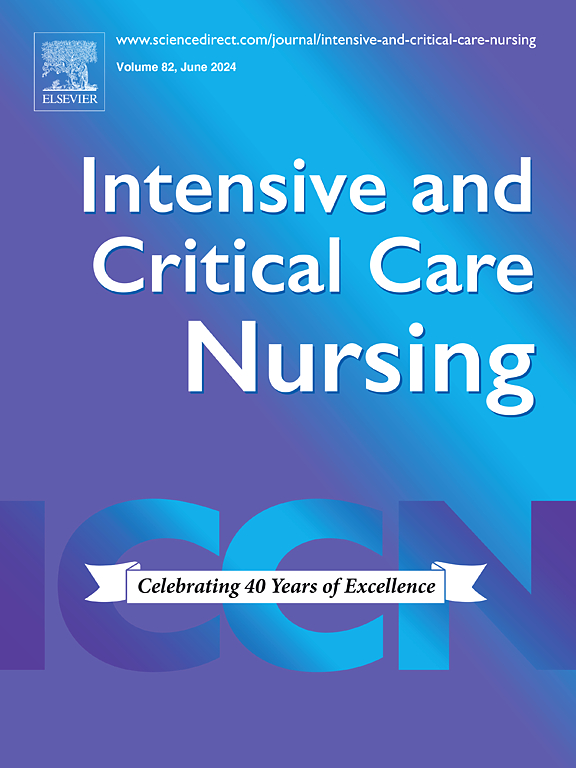斯堪的纳维亚医护人员对重症监护病房康复措施的看法。横断面调查。
IF 4.7
2区 医学
Q1 NURSING
引用次数: 0
摘要
目的描述医护人员对当前早期康复实践及其先决条件的看法,重点是斯堪的纳维亚重症监护病房(ICU)中护士和其他医护人员所提供的功能和认知刺激:设计:对医护人员进行横断面电子调查。该调查以丹麦语编写,翻译成挪威语和瑞典语,并使用谷歌表单进行发布。采用框架法对定性数据进行分析:地点:斯堪的纳维亚重症监护病房:重症监护病房的护士和其他医护人员所采取的措施通常始于断开呼吸机和减少镇静剂。随后是加强活动和增强体力。他们还关注优化营养、吞咽功能和口腔摄入。此外,还将促进交流、开展认知刺激活动和身体刺激活动以调动患者的思维也纳入了康复治疗的范畴。为避免谵妄和过度劳累,重要的是要平衡休息和活动,使病人免受不必要的刺激。此外,重要的是要支持病人的生活意愿,并让家属参与康复。出院后的康复活动包括与出院到病房和家中的病人联系:结论:随着患者意识和体力的恢复,康复被描述为从被动到主动的过程。断奶、平衡休息和活动、支持患者的生活勇气和康复意愿、开放探视政策以及多专业合作是康复的重要前提:对实践的启示:病人护理的各个方面都是身体和认知康复的重要机会。平衡休息和活动对于保存患者的康复能量非常重要。本文章由计算机程序翻译,如有差异,请以英文原文为准。
Scandinavian healthcare professionals’ perceptions of rehabilitation practices in the intensive care unit. A cross-sectional survey
Objective
To describe healthcare professionals’ perception of current early rehabilitation practices and their preconditions, focusing on functional and cognitive stimulation facilitated by nurses and other healthcare professionals in Scandinavian intensive care units (ICUs).
Design
Cross-sectional electronic survey administered to healthcare professionals. The survey was developed in Danish, translated into Norwegian and Swedish, and delivered using Google Forms. The qualitative data were analysed using the framework method.
Setting
Scandinavian ICUs.
Results
Practices facilitated by nurses and other healthcare professionals in the ICU often began with weaning from the ventilator and reducing sedation. This was followed by increased mobilisation and building physical strength. There was attention to optimising nutrition, swallowing function, and oral intake. Enabling communication and employing cognitively stimulating activities and bodily stimulation to engage the patient’s mind were also framed as rehabilitation. To avoid delirium and overexertion, it was important to balance rest and activity and to shield the patient from unnecessary stimulation. Furthermore, it was important to support the patient’s will to live and to involve the family in rehabilitation. Post-discharge rehabilitation activities included reaching out to patients discharged to wards and homes.
Conclusion
Rehabilitation was described as progressing from passive to active as patients gained consciousness and strength. Weaning, balancing rest and activity, supporting the patient’s life courage and will to recover, open visitation policies, and multi-professional collaboration were important prerequisites for rehabilitation.
Implications for practice
All aspects of patient care can function as important opportunities for physical and cognitive rehabilitation. Balancing rest and activity is important for conserving the patient’s energy for rehabilitation.
求助全文
通过发布文献求助,成功后即可免费获取论文全文。
去求助
来源期刊

Intensive and Critical Care Nursing
NURSING-
CiteScore
6.30
自引率
15.10%
发文量
144
审稿时长
57 days
期刊介绍:
The aims of Intensive and Critical Care Nursing are to promote excellence of care of critically ill patients by specialist nurses and their professional colleagues; to provide an international and interdisciplinary forum for the publication, dissemination and exchange of research findings, experience and ideas; to develop and enhance the knowledge, skills, attitudes and creative thinking essential to good critical care nursing practice. The journal publishes reviews, updates and feature articles in addition to original papers and significant preliminary communications. Articles may deal with any part of practice including relevant clinical, research, educational, psychological and technological aspects.
 求助内容:
求助内容: 应助结果提醒方式:
应助结果提醒方式:


